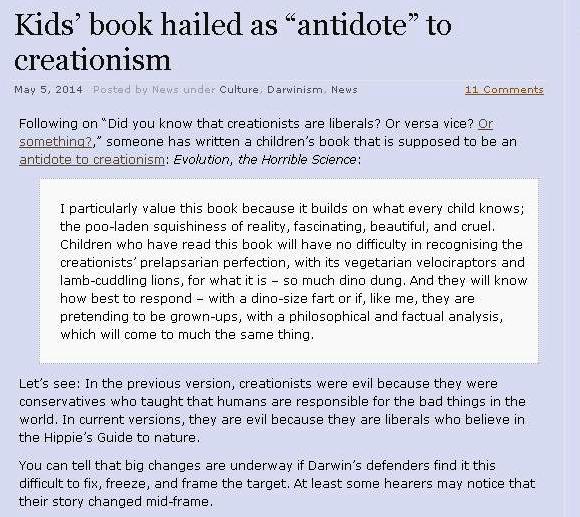I’ve been attacked by the Discovery Institute’s Uncommon Descent. That’s not interesting. What’s interesting is the reason; they caught me making fun of Young Earth creationism.
In my last post, I described Evolve or Die, a children’s book published in 2008 that I recently came across, as an “antidote to creationism”, and poked fun at Young Earth creationists for believing that carnivores were vegetarians, and dinosaurs coexisted with humans, in a perfect world before the Fall. This, at any rate, is what they say they believe, as perusal of the UK Creationist Christian Schools Trust policy on teaching evolution, or of the contents of Ken Ham’s Creation Museum, will quickly verify. (For documentation of all this in earlier blog posts, see here and here and here.)
 For saying this, I would expect criticism from openly creationist sources such as Answers in Genesis or Creation Ministries International. But Uncommon Descent isn’t supposed to be like that. It claims, as you can see, to serve the Intelligent Design community. This is not supposed to be creationist, and I have seen the Director of the Centre for Intelligent Design, the Discovery Institute’s UK franchise, go red in the face denying that creationism and Intelligent Design have anything to do with each other.
For saying this, I would expect criticism from openly creationist sources such as Answers in Genesis or Creation Ministries International. But Uncommon Descent isn’t supposed to be like that. It claims, as you can see, to serve the Intelligent Design community. This is not supposed to be creationist, and I have seen the Director of the Centre for Intelligent Design, the Discovery Institute’s UK franchise, go red in the face denying that creationism and Intelligent Design have anything to do with each other.
Others have drawn attention to the Discovery Institute’s cries of “gagging order” when Ball State University stopped the teaching of theocentric Intelligent Design as science, and their support for the Bryan University administration as merely asserting its rights when it suddenly demanded that their faculty members profess belief in a literal Adam and Eve. A double standard; demanding unconstitutional privilege for creationism in the name of academic freedom, while turning a blind eye when such freedom is trampled on by the creationists themselves.
It is worth quoting the words with which the DI’s mendaciously mistitled Evolution News and Views defends the Bryan administration against its own faculty:
[A] private institution like Bryan with a religious or philosophical mission inevitably draws lines for its teachers. If you want to retain the mission, you can’t at the same time tell faculty that “Anything goes.”
Remember that when next you hear the Discovery Institute argue for the “academic freedom” to teach creationism in publicly funded schools.
But their explicit defence of Young Earth creationists against their critics is something new. For the record, here’s the actual article. No author name given. Yes, that’s all of it, including what I accept as a full and fair embedded quote from what I wrote. A pity the surrounding text is so incoherent[1], but my assertion that the DI is defending creationism is an extraordinary claim, and extraordinary claims require extraordinary (if tedious) evidence:
And just to spell it out, they describe my review of a 5 year old book as part of the latest attack on the poor beleaguered creationists, because I scurrilously refer to what creationists believe, thereby unfairly accusing them of being “liberals who believe in the Hippie’s [sic] Guide to nature”. And the interesting bit is, not the boring banality and involuted illogic of Uncommon Descent, which is standard, but the fact that they think their job includes defending Young Earth creationists.
One final detail. I am not a defender of Darwin, just as when I talk about the chemical elements I am not a defender of Lavoisier, or when I invoke classical mechanics I am not a defender of Newton. Physics, chemistry, and biology are very different from what they were in the 17th, 18th, and 19th Centuries respectively, even if the creationists Intelligent Designers refuse to notice.
Illustration: Creation Museum tableau showing humans living peacefully before the Fall with vegetarian tyrannosaurs. Public domain photo, taken with permission to share by Anthony5429, obtained through http://en.wikipedia.org/wiki/File:Creation_Museum_10.png
Technical note: I use HTML nofollow for links to DI and other creationist sites, so as not to boost their click counts and advertising revenues.
[1] They even muddle up the title of my review with that of the book I was reviewing.







